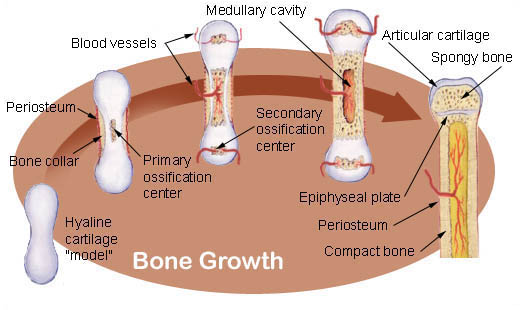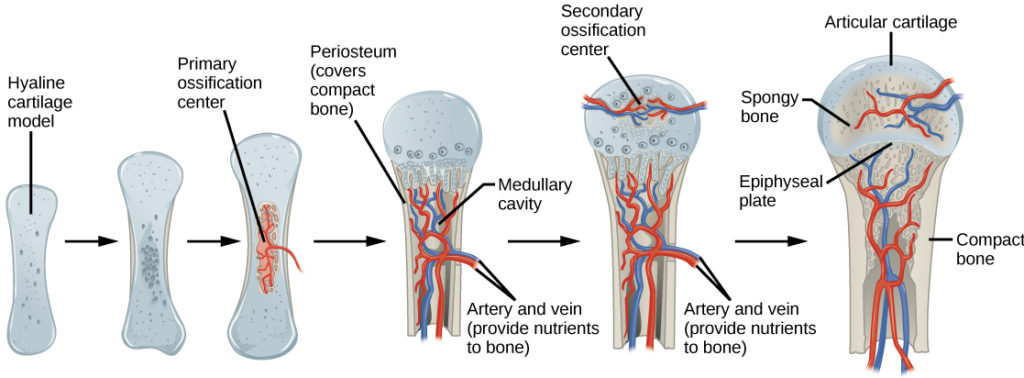Describe the Process of Bone Formation
The process of bone formation is called osteogenesis and that of their calcification is termed as ossification. Ossification is the process of bone formation.

6 4 Bone Formation And Development Anatomy Physiology
The process of ossification uses calcium to create bone as the child grows and matures.
. When the remodeling process is skewed such that over time there is more eating than replenishing you get osteoporosis. In this process mesenchymal. This process begins early in fetal development usually by the end of the eighth week after conception.
By this process the bones that are located in. Bone formation occurs by osteoblasts secreting an organic matrix osteoid and then mineralizing the matrix. In intramembranous ossification bone develops directly from sheets of mesenchymal connective tissue.
During bone formation woven bone haphazard arrangement of collagen fibers is remodeled into lamellar bones parallel. All bone formation is a replacement process. In humans the process of bone formation begins during 6-8 weeks of embryonic development 1.
It is the form of ossification where there is. In intramembranous ossification bone develops directly from sheets of mesenchymal connective tissue. First the hyaline cartilage model is completely covered with bone matrix a bone collar by bone-forming cells called osteoblasts.
Bones at the base of the skull and long bones form via endochondral ossification. Intramembranous ossification forms flat and irregular bones. By the sixth or seventh week of embryonic life the actual process of bone development ossification osteogenesis begins.
Conclusions Osteogenesisossification is the process in which new layers of bone tissue are placed by osteoblasts. By the end of the eighth week after conception the skeletal pattern is formed in cartilage and connective tissue membranes and ossification begins. Secondary ossification occurs after birth at the epiphyses of long bones and continues until.
In order to. Early in fetal development the skeleton is made of cartilage. IntroductionIntroduction Bone is a relatively hard and lightweightBone is a relatively hard and lightweight composite material formed mostly ofcomposite material formed mostly of calcium phosphatecalcium phosphate Bone can be.
Bone Development Growth. The process may be part of the normal regulation of minerals such as Calcium in the blood or it could also be due to a pathological or disease process which accelerates the rate of bony breakdown. In endochondral ossification bone develops by replacing hyaline cartilage.
Stages of bone formation 1. Although this varies slightly based on the individual. Mesenchymal cells condense into a connective tissue membrane.
Process of formation of bone tissue along with the deposition of calcium in the fetal hyaline cartilage is known as ossification. Calcium phosphate enzyme helps create hard bone from these sources. When the remodeling process is aborted say in avascular necrosis bad bone accumulates.
As the bone develops more bone is formed from the center outward towards the ends of. In the early stages of embryonic development the embryos skeleton consists of fibrous membranes and hyaline cartilage. Seen here as density.
During development these are replaced by bone during the ossification process. Bone resorption is the process of braking down the bones into its mineral and collagenous constituents through a cellular mechanism. During development tissues are replaced by bone during the ossification process.
By this point the skeletal pattern is formed by cartilage and connective tissue membranes and ossification begins. This process occurs primarily in the bones of the skull. This process begins in the middle of the newly forming bone at a site called the primary ossification center.
In this process the formation of the compact and spongy bone takes place directly from the sheets made of the undifferentiated mesenchymal connective tissue. In a long bone for example at about 6 to 8 weeks after conception some of the mesenchymal cells differentiate into chondrocytes cartilage cells that form the cartilaginous skeletal precursor of. Calcium phosphate salts are incorporated into osteoid matrix osteoblasts are surrounded and become osteocytes.
Bone ossification or osteogenesis is the process of bone formation. This process begins between the sixth and seventh weeks of embryonic development and continues until about age twenty-five. This method is most common in long bones of the body like the shaft of the femur.
There are two processes of bone formation they are Intramembranous ossification and endochondral ossification. Mesenchymal cells condense and differentiate. Bone remodeling or bone turnover is.
The skeleton is a source of calcium. There are two osteogenic pathwaysintramembranous ossification and endochondral ossificationbut bone is the. Endochondrial bone formation begins with a cartilage precursor that proliferates hypertrophies and becomes imbedded in the core of bone.
With age bones lose. During fetal development bone tissue is created through intramembranous. Parts of the skeleton form during the first few weeks after conception.
Proper formation of bone depends on sources of calcium phosphorous and vitamin D. Osteoblasts and osteoclasts work to deposit and tear down bone throughout life. Mesenchymal cells differentiate into osteoblasts osteoid is secreted and forms bone spicules.
Except for flat bones which form on fibrous membranes most bones develop using hyaline cartilage structure as their models Most simply this process of bone formation or ossification involves two major phases. Spicules continue to develop the spaces inbetween form the marrow cavity the outer and inner. The terms osteogenesis and ossification are often used synonymously to indicate the process of bone formation.
This can begin as early as a few weeks after conception. Ossification is of two types - A Intramembranous ossification. The blastula differentiates into three germ layers.
All bone formation is a replacement process. Bones gradually become hard and strong. An important point here.
There are two types of bone ossification intramembranous and endochondral. The process can be broken down into two types of bone growth. The direct conversion of mesenchymal tissue into bone is called intramembranous ossification.
Embryos develop a cartilaginous skeleton and various membranes. Ossification or osteogenesis is the process of bone formation. There are two major modes of bone formation or osteogenesis and both involve the transformation of a preexisting mesenchymal tissue into bone tissue.
Periosteum is a connective tissue layer on the outer surface. Growth andGrowth and Development of BoneDevelopment of Bone 2. First a cartilage model of the bone is formed.
Bone Formation Embryonic and Fetal Bone Formation.

Seer Training Bone Development Growth


No comments for "Describe the Process of Bone Formation"
Post a Comment